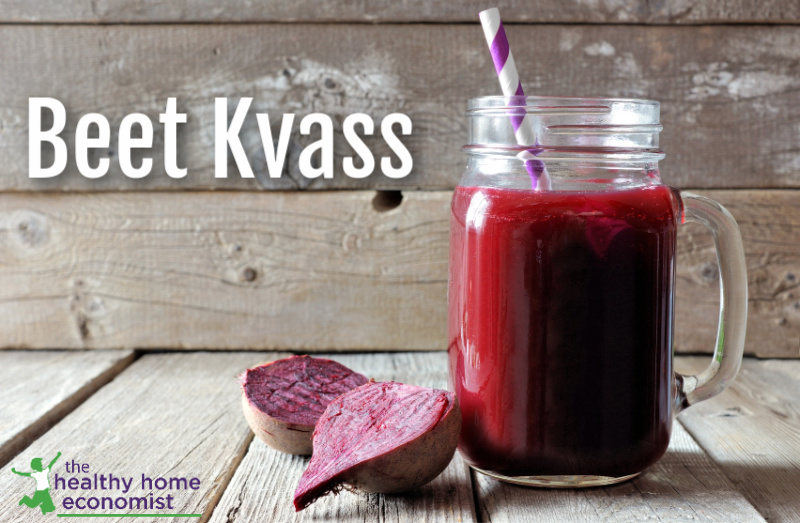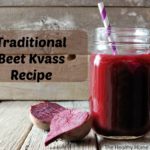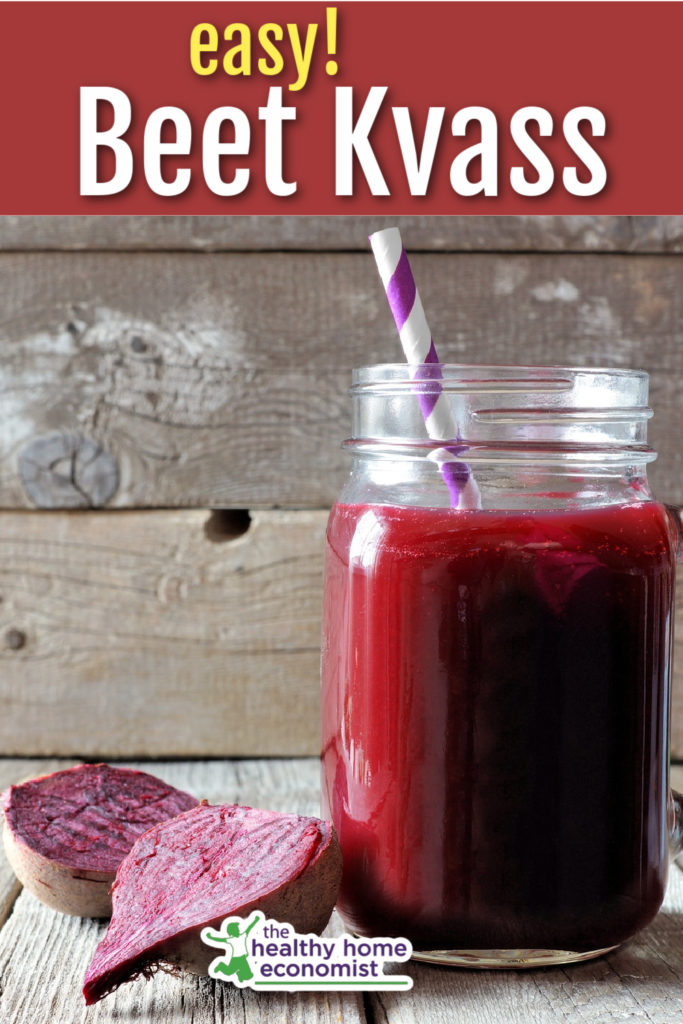Table of Contents[Hide][Show]
Beet kvass is potent, nutrient-rich tonic made by fermenting beets. It is essentially a DIY liquid multivitamin and more effective than taking brands from the store that contain synthetics!

One of the most nutritious and health-boosting fermented beverages you can make in your home is beet kvass. Beets are chock full of vitamins and minerals. Fermenting them supercharges nutrient levels even further and enhances absorption potential.
This ancestral tonic is extremely beneficial to those with any sort of digestive complaints.
In addition, beets are highly cleansing, so those with liver issues benefit from consuming beet kvass on a regular basis.
There isn’t another fermented drink that can improve health as rapidly in my personal experience.
Beet Kvass: DIY Liquid Multivitamin!
As a tonic, beet kvass is recommended first thing in the morning and after your evening meal.
Just 4 ounces or so is all you need to sip.
This highly nutritious superfood is far better than taking a multivitamin loaded with synthetic vitamins like folic acid.
I’m sipping a morning glass of beet kvass as I type this! What a great way to start the day and rev up your digestion each morning!
The recipe below was adapted from Nourishing Traditions Cookbook.
Most people make kvass with red beets. For a slightly sweeter and less earthy flavor, try making golden beet kvass.
If you find the results a bit salty, reduce the sea salt in the recipe to your liking.

Beet Kvass Recipe
Traditional beet kvass recipe that is an unbeatable morning and evening tonic for rapidly boosting health.
Ingredients
- 1-2 beets (1 large or 2 medium) preferably organic, tops removed
- filtered water
- 2 Tbl liquid whey
- 1/2 Tbl sea salt
Instructions
-
Wash beets thoroughly and slice into chunks no smaller than about 1/2 inch across. Feel free to peel the beets if desired; doing so reduces chances for mold on the ferment.
-
Put beet chunks into a clean, one-quart mason jar. Add whey, sea salt, and enough filtered water to fill all but 1 inch from the top of the jar. Stir and mix well. Close the lid and leave on the kitchen counter for 1-2 days. Try to keep it away from the fruit bowl to discourage the growth of mold.
-
Drink as desired and refrigerate once the fermentation period is complete. A 4 ounce glass morning and evening is recommended.
-
When an inch or so of beet kvass liquid is left in the jar, refill with more filtered water, stir, and close the lid again and leave on the counter for 2 days more. Refrigerate fresh batch of beet kvass and drink as desired.
-
When all the liquid is used up from the second batch, discard or compost the beets and start the process again.
Recipe Video
Recipe Notes
If the beet kvass is too salty for you, feel free to reduce the salt to 1/4 tablespoon for your next batch.
White fuzzy bubbles forming on the top of the liquid is normal and fine as the fermentation progresses.

More Fermented Drink Recipes to Enjoy
How to Make Fermented Lemonade
Orangina Recipe (Fermented Orange Juice)
How to Make Kombucha








Hi Sarah! I made the kvass with whey from kefir and was hoping you could help describe the proper flavour I should taste? It didn’t produce any bubbles at all, and is not really tangy (which I guess I was expecting from something fermented) .. I could almost taste a whey flavour still afterwords – is that normal? Thanks!!
Depending on the temperature of your kitchen, the beet kvass can turn out more or less bubbly with each batch. Cooler kitchens produce less effervescent results. It’s hard to describe the flavor as it is so unique. As long as you followed the recipe properly and didn’t get mold, you are good!
When I buy beet kvass from my CSA it tastes way different than when I make it – it tastes better! I have been making the 2 quart recipes from nourishing traditions but otherwise everything the same. Any pointers if your kvass tastes bland?
Thanks!
Using the best quality organic beets is what makes the best tasting beet kvass 🙂
I can only get fresh organic beets once a year in the fall. How long can I store the kvass in the fridge if I were to make many batches? I also thought that I might be able to freeze some beets for later use but I don’t know if that would work. Please comment. Thankyou
I don’t know. I’ve not frozen beets before. One thing you could do is make a lot of beet kvass and freeze that.
please discuss the issue of mold further.. mine keeps getting a multi colored layer of mold… mostly white… but I discard the whole batch because of it.. how can i avoid so much mold forming? Also, I live in Phoenix and our home is 80 degrees because it is summertime!
I know that this has been touched on a lot but I’m still unclear about the issue of mold. Most recipes warn against mold in some form in fact even your video offers a suggestion to avoid mold growth. However, I’ve read several times not to worry about it and to skim it off and drink it… Every time I have made Kvass I end up with mold – green, fuzzy mold. Is there any health concern when drinking something that has had mold growth?? Any advise is greatly appreciated as the topic seems somewhat ambiguous. Kind regards,
I am on a no-dairy diet, so I don’t make yogurt and whey. What can I use instead? I have found a non-dairy yogurt starter by Belle+Bella. Would that work?
Hello-
Can Beet kvass still be o.k. to consume if it has been left in the refrigerator for one year?
Thank you.
P.S. We put a lot of salt into this batch.
Probably not.
Beet Kvaas will hold almost indefinily refrigerated. It will continue to ferment but very slowly. Also, you have to ferment Beet Kvaas a minimum of one and one half weeks in order to obtain the production of pre- and probiotics to be of any nutritional/medicinal value. Otherwise all you have is a tasty drink. Long ferment times are required (ie. sauerkraut must sit for 30 days) to develop the full compliment of pre- and probiotics and to access the micro nutrients of the vegetable. Also, you must never heat or freeze fermented foods or you totally destroy the nutritive/medicinal (prebiotics and probiotics) benefits we ferment vegies for.
Best of health to you and your readers!
Looking forward to making this as soon as my local food co op has organic beets.
The addition of 2-3 sliced garlic cloves takes away the ‘earthy’ taste!
can’t get organic beets….so is this worth the effort?